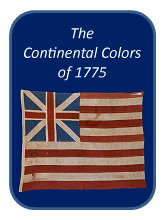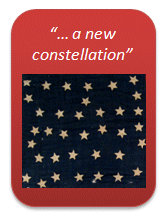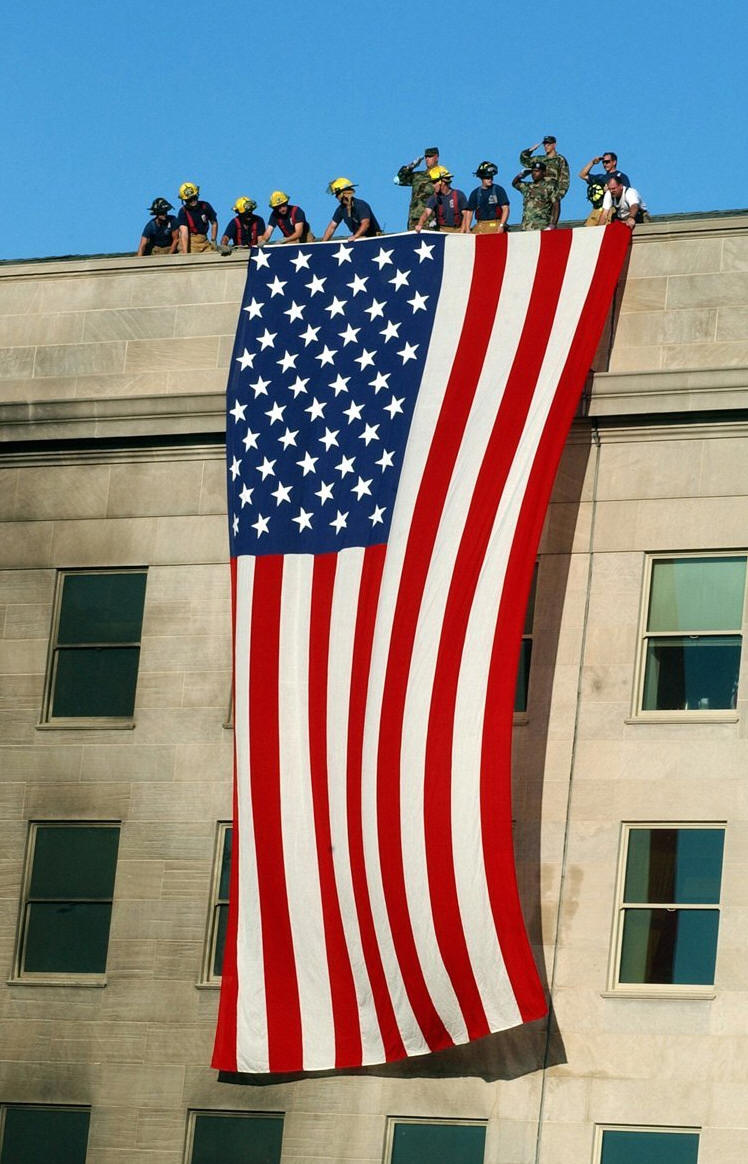
The history of the
American Flag is long and storied. Our
flag is one of the most dynamic of any flag of
any nation. It reflects the growth of the
nation, from the original 13 Colonies to our
current union of 50 States. The flag was
present on the battlefields of the Revolution,
over Fort McHenry, draped from President
Lincoln's theater box where he was assassinated,
carried to the poles, carried onto the beaches
of Normandy, flown to and planted on the moon,
and found, tattered and torn, but otherwise
intact, in the debris of the World Trade Center.
Below is a historical timeline that highlights
some significant events related to the history
of our flag.
 |
During the
first year of the American Revolution,
American military forces, and in particular
the American Navy, required a flag to
distinguish ships and units of the
Colonies from those of Great Britain.
The Continental Colors, documented to
have been flown by John Paul Jones
aboard the ship Alfred as early
as December 5, 1775, represented the
United States during the first two years
of the Revolutionary War. Known
today as the Grand Union Flag, it is
considered the first National Flag of
the United States. American forces
fought under the Continental Colors
during the period of the signing of the
Declaration of Independence, until the
Union Jack canton of Continental Colors
was replaced by the starry constellation
of the Stars and
Stripes with enactment of the first Flag Act of
June, 1777.
|

A
Centennial Era example of the
Continental Colors, c1876. |
 |
On June
14, 1777, the Second Continental Congress
passed the first Flag Act, that replaced
the Continental Colors that had
represented the Colonies through from
1775 to through the first half of 1777
with the Stars and Stripes.
"Resolved, That the flag of the United
States be made of thirteen stripes,
alternate red and white; that the union
be thirteen stars, white in a blue
field, representing a new
Constellation."
The
concept of a Constellation of white
stars was an elegant and appropriate
description of the canton of the flag,
which would come to represent the
individual states themselves.
Whether the framers intentionally
omitted any further guidance,
considering the fact that constellations
of stars can and do consist of an
unlimited number of possible star
arrangements, is unknown. But it
is precisely because of this lack of
guidance that we see the unlimited
number of variations in the American
flags that would follow.
|

A beautiful "constellation"
of 36 stars on a flag of the Civil War
era
c1865. |
 |
In
response to the addition of Vermont and
Kentucky, Congress acted once again
to provide
guidance
on the flag. The Second Flag Act,
signed into law by President George
Washington,
did not demonstrate the forethought that
previous and subsequent
flag acts would exhibit, instead
decreeing:
"That the
flag of the United States be fifteen
stripes, alternate red and white and
that the union be fifteen stars, white
in a blue field."
By once
again specifying the number of
stars, and in this case, the number of
stripes as well, the act was destined
for obsolescence as yet more states
would continue to join the Union.
Nevertheless, the most famous and
cherished of all American flags, the
Star Spangled Banner, would be produced
under this flag act and conform to its
specifications of 15 stars and 15
stripes.
. |

The
Star Spangled Banner,
our most cherished flag c1813 |
 |
Realizing that a more permanent solution
was needed to keep the flag properly updated,
Congress passed the Flag Act of 1818 on
April 4, 1818. This act, which
would remain the final official guidance
on the U.S. flag for nearly a century,
was signed by President James Monroe.
"An Act to establish the flag of the
United States. Be it enacted by the
Senate and House of Representatives of
the United States of America, in
Congress Assembled, That from and after
the fourth day of July next, the flag of
the United States be thirteen horizontal
stripes, alternate red and white: that
the union be twenty stars, white in a
blue field. And be it further enacted,
That on the admission of every new state
into the Union, one star be added to the
union of the flag; and that such
addition shall take effect of the fourth
day of July then next succeeding such
admission."
The
flag was an excellent compromise,
allowing the stars to grow, the thirteen
stripes remaining representative of the
original 13 colonies, and a firm date by
which a new flag would become official.
|

A jubilant star added to welcome yet
another
new state
c1867 |
 |
The era of
unbridled creativity in arranging stars
on the cantons of U.S. flags came to an
end in 1912, when President William
Howard Taft issued an Executive Order
dated June 24, 1912, which established
the proportions of the flag and an
arrangement of six horizontal rows of
eight stars each for a total of 48.
Only minor modifications made by
President Eisenhower in 1959, once for
the admission of Alaska (49) and then, a
year later for the admission of Hawaii
(50), bring us to the flag we know
today. |

One of the last
"great constellations", this
48 star canton represents the end of an
era
c1912. |
 |
The
American flag, one of the most
recognizable symbols in the world.
 |
The beautiful
Stars and Stripes of 50 Stars, hung with full
military
honors over the damaged south wing of the
Pentagon on October 11, 2001. |

